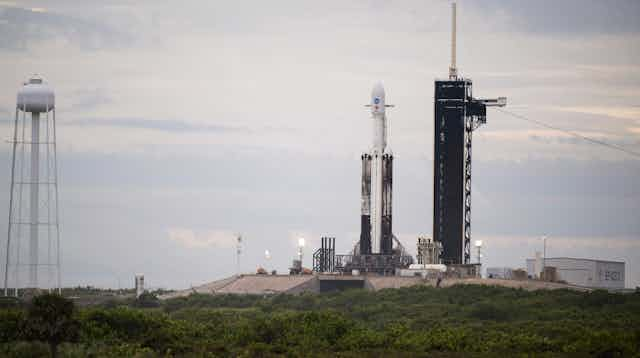It’s unlikely to be a bad omen, but Nasa’s mission Psyche is currently due to launch on Friday 13 October. Lifting off at 10.19 EDT on a SpaceX Falcon Heavy rocket, it faces a perilous journey and isn’t scheduled for arrival at its namesake asteroid, 16 Pscyhe, until 2029.
Asteroid 16 Psyche (meaning “soul” in Greek) was discovered in 1852 and is named after an ancient Greek princess who married Eros (the namesake of another asteroid). It orbits the Sun in the main asteroid belt between Mars and Jupiter, at approximately three times the distance from the Sun as Earth. It is a massive M-type asteroid (M stands for “metal-rich”), over 230km across.
Astronomers have to be careful with the term metal though, as in stellar physics “metallicity” means anything heavier than helium. In this case though, we are talking about metals such as iron and cobalt.
To give an idea of scale, if the Sun was shrunk down to the size of an official NBA basketball, then the asteroid’s diameter would be about the same size as the thickness of three pieces of paper (0.3mm), and located at a distance of 161 metres away.
As you can see, a mission to an object so small is not straightforward, although smaller objects have been visited – for example the recent sample return of OSIRIS-REX from asteroid Bennu or the Hayabusa 2 mission to 162173 Ryugu.
To accomplish this remarkable voyage, the Psyche spacecraft, once launched, will use solar-electric propulsion. This works by using an electrically charged gas that’s accelerated out of the rocket nozzle by a powerful electric field. This form of propulsion, unlike a chemical rocket, produces very modest thrust. But it can operate continuously over many months or even years, while using comparatively little fuel.
The technology is very useful for long-distance interplanetary missions, but it does require a decent amount of sunlight for the spacecraft’s solar panels to generate the necessary electrical power. Lucy, another recently launched Nasa mission to asteroids in the outer Solar System, uses the same propulsion.
Mission goals
So what makes this particular asteroid interesting? Planets are born in “protoplanetary disks” through a process called accretion. This involves small bits of material gradually acquiring more mass from gravitational attraction and collision with other nearby material.
Technically, this is an ongoing process as the Earth sweeps up some 100 tons of natural debris every day as it orbits the Sun. However, the bulk of a planet’s mass is acquired within the first few million years of its existence.
This is typically an extremely violent epoch in which catastrophic collisions between young worlds are common. Needless to say, not every planet to be survives to full planethood. And 16 Psyche may be an example of such as “stunted” planet.
If there’s enough internal radioactive decay and heat released by countless impacts during planetary formation, a young world will melt and undergo a process called “differentiation”, in which heavier material sinks to the core and lighter material floats to the surface.
There are several models of formation for 16 Psyche, but the simplest one consistent with present evidence is that 16 Psyche appears to have undergone differentiation, but subsequently suffered a catastrophic impact with another young world – obliterating the outer layers, leaving a remnant dense metal-rich core exposed to space.
A key science objective of the Psyche mission will be to distinguish which of these models is most likely correct.
There are two main reasons for visiting Psyche. One is the scientific interest in visiting an object that could be similar to the iron core of a planet – including the Earth. The second is to found out whether it is possible to mine the metals – with Forbes calling it a “quadrillion-dollar asteroid”.
Venturing into the centre of a planet to directly study its core is impossible with our current technology. However, visiting an exposed planetary core provides an excellent opportunity to test our current models of planetary formation.
The Psyche spacecraft carries a number of scientific instruments such as an imager for mapping the surface of the asteroid, a gravity experiment to help to determine the world’s interior structure, and a spectrometer for investigating the mineral content of the asteroid’s surface.
One of the instruments is a magnetometer which is designed to try and detect whether 16 Psyche has a magnetic field. This is useful because any remnant magnetic field could demonstrate that Psyche’s interior was once indeed molten and underwent differentiation.
As long as the spacecraft reaches the asteroid safely, there are great discoveries to look forward to. It will certainly provide a wealth of data for scientists to analyse back on Earth for years to come.

